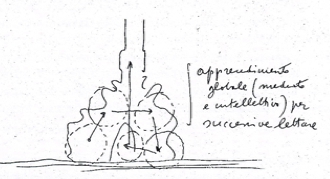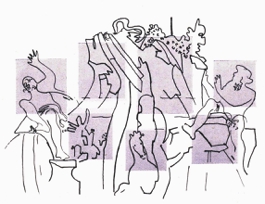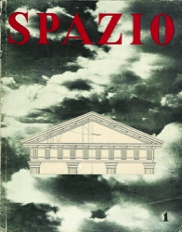
For Seligmann and his cohorts, reading Spazio at this time was a distinctly renegade activity. And I suspect that, in greatly expanding the repertoire of historic precedents and in speculating on their potential kinships to modernism, Spazio presented an attitude toward modern architecture that was rarely to be found elsewhere, even in some of the more forward-looking and retrospective journals of the time (like Arts & Architecture). And these attitudes were instrumental in influencing many of Werner Seligmann’s beliefs.
The articles in Spazio would usually take the form of an analysis: verbal, graphic, and sometimes ambiguously both. Each issue contained at least one essay in which Moretti and occasional guest artists, critics, and historians would analyze certain aspects of the arts, with Moretti often loosely extrapolating these works’ relationships to architecture. For Moretti, analysis was intimately tied to the design process, not simply an attempt to understand what might have transpired in the past, but to more fully understand what is and could be happening in the present. Moretti's analyses represented a process in motion: we read them not as finished works, but as unconstrained ruminations—as often brilliant as they were occasionally a bit reckless—always attempting to draw the reader into a speculative discourse.
Moretti begins Spazio’s very first issue with "Eclecticism and Unity of Language," introducing his affinity for the baroque (which he later described as a "high and esoteric language") and his skepticism regarding the notion that each age subscribes to a unique expressiveness, that is, he expressed his disbelief in a determinate zeitgeist. He finds modern expressionism present in the brush strokes of Rubens, and surrealism in the fabrics of fifteenth century paintings by Cossa. Eclecticism, according to Moretti, is not only a necessity in a complex, multi-cultural world, but, interestingly, he claims that it is most admirably practiced in America, citing, for example, the design of high-rise buildings in Manhattan and Chicago.
This notion of eclecticism is extended in the third issue’s essay "Abstract Forms in Baroque Sculpture," where Moretti treats the three-dimensional works of Bernini and Borromini as abstract compositions in which exuberant draperies and the wings of angels seem to be formulating the plasticity that defines Roman baroque architecture. Rather than encourage a stationary viewer, these fluid forms lead the eyes from one center to another in works composed of multiple focal points, cascading from one thematic system to another—a virtual architectural promenade. And more than with Le Corbusier’s promenade architecturale, Moretti’s “promenade” could often be accomplished with the movement of the eye, much as one might move through a painting. Throughout his essays, Moretti reveals a fascination with movement, sequence, and time as modifiers of space and form.
Also, Moretti would often juxtapose images of a portion of a painting, a fragment of a sculpture, an element of a building (occasionally placed on its side to emphasize its compositional aspect), letting the reader make associations and draw conclusions. With Spazio, the reader is invited to take an active role. It is an evocative analysis established by juxtaposition, a strategy of presentation, incidentally, very typical of Colin Rowe, inherited from Rudolf Wittkower, and passed on to Werner Seligmann. And it seems always equally essential to Seligmann that the “reader” draw conclusions, or at least be drawn to draw conclusions.

Fig 6 a, b Luigi Moretti: top, diagram of Bernini’s Fontana dei Quattro Fiumi, Rome, 1651; details and focal itineraries; top, from Spazio 3; bottom, from “Strutture da insieme,” April 1963, Spazio extracts.
Fig 5 Cover of Spazio 1, designed by Angelo Canevari. The cover art, with its partial proportional drawing of the gable of a Doric temple, hovering in a romantic, cloudy sky, already signals the editorial position Moretti will be pursuing.
Introduction page 5
